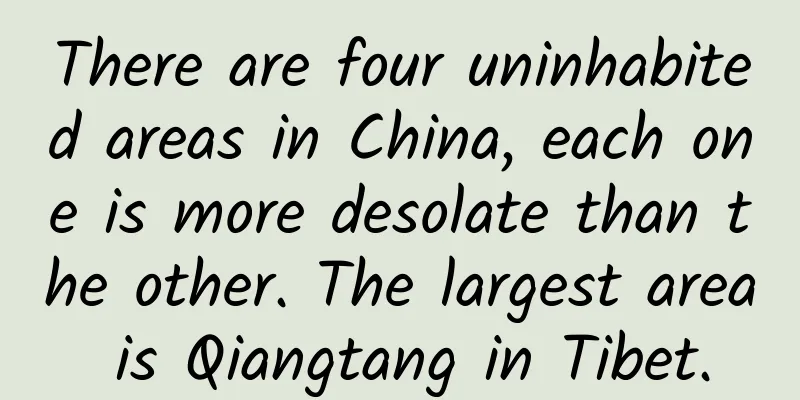There are four uninhabited areas in China, each one is more desolate than the other. The largest area is Qiangtang in Tibet.

|
Although my country now has a population of about 1.4 billion, it has 9.6 million square kilometers of land. Not every place is inhabited, and the population is mainly distributed in plains and coastal areas and other low-altitude areas. In some places with harsh conditions (drought, lack of water, high altitude and lack of oxygen), there are many uninhabited areas. Of course, uninhabited areas are not absolutely uninhabited, but they are extremely sparsely populated. Among them, Lop Nur, Altun, Hoh Xil and Qiangtang are known as the four major uninhabited areas in China. They are one of the most dangerous and difficult hiking routes in China and are known as the "forbidden zone of life". 1. Lop Nur, Xinjiang Lop Nur is located at the lowest point in the eastern part of the Tarim Basin, on the eastern edge of the Karamak Desert, about 780 meters above sea level, in the southeast of Xinjiang. It is a dried-up inland lake. To the northwest of the lake is the famous ancient city of Loulan. The Tarim River, Kongque River, Cherchen River, Shule River and other rivers all converge here. If it had not dried up, it would definitely be the second largest saltwater lake in China after Qinghai Lake. Now the second largest saltwater lake in China is Namtso Lake in Tibet. Affected by the amount of water upstream, the area of Lop Nur Lake often changes. In 1931, Chinese scholar Chen Zongqi and German geologist Hornier measured the entire lake area and found that the area of Lop Nur was 2,375 square kilometers. In 1941, the area of the lake was measured to be about 3,000 square kilometers on a Soviet 1:500,000 topographic map. Archaeological discoveries show that before 330 AD, there was more water in Lop Nur, and the lake area may have been as high as 10,000 square kilometers. Later, due to climate change and the impact of human water conservancy projects, the water flow from upstream (especially the Tarim River) decreased, and Lop Nur finally dried up completely in the 1970s. Now only a large area of salt crust remains, making it one of the most desolate places in the world. In the 1960s, before Lop Nur was completely dried up, my country's first atomic bomb and hydrogen bomb were successfully tested in the Lop Nur area. The reason for choosing this place is that Lop Nur and its surrounding areas are uninhabited areas. After Lop Nur dried up, the surrounding ecological environment changed dramatically. All kinds of plants died. Soon Lop Nur merged with the Taklimakan Desert and became extremely dry. From then on, it became a place where no grass grew and was called the "Sea of Death." In the 1980s, the famous scientist Peng Jiamu led an expedition team to carry out China's first mission to cross the core area of Lop Nur, but disappeared during the mission. 2. Altyn, Xinjiang The Altyn region is mainly the area where the Altyn Mountains are located. The Altyn Mountains are a mountain range in the southeast of Xinjiang and are the boundary mountains between the Tarim Basin and the Qaidam Basin. The Altyn Mountains have an average altitude of more than 3,000 meters and are connected to the Qilian Mountains in the east. The Dangjin Pass between the two mountains (located at the junction of Gansu, Qinghai and Xinjiang) is the main transportation route between the Qaidam Basin and the Hexi Corridor. The Altyn Mountains face the Kumtag Desert to the north and the Qaidam Basin to the south. They belong to the northwest desert. The region is dry and rainless, windy and dry, lacking oxygen and cold, so the vegetation is poor and sparsely populated. The temperature difference between the four seasons is large, with long and cold winters and short summers, and the ice and snow period lasts up to 9 months. There are small glaciers on the mountains, and the Ruoqiang River and the Milan River originate here. Because the conditions in the region are harsh and unsuitable for human survival, few people have set foot in the Altyn region. However, this place has become a paradise for wild animals. A national nature reserve with an area of 45,000 square kilometers has been established in the area - the Altun Mountain Nature Reserve, where there are dozens of precious protected animals such as Tibetan antelopes, wild yaks, and Tibetan wild donkeys. At the eastern end of the Altun Nature Reserve, there is an area called Devil's Valley. After investigation by scientific researchers, it was discovered that Devil's Valley is a lightning strike area. There is a large area of strongly magnetic basalt underground and more than 30 iron veins of various sizes. In addition, there are often thunderstorm clouds in the sky above the valley, so thunderstorms often occur. 3. Hoh Xil, Qinghai The Hoh Xil region is mainly located in Qinghai and northern Tibet (Qiangtang Grassland), with a small part in Xinjiang, with a total area of 235,000 square kilometers. The Hoh Xil uninhabited area we are referring to is the Qinghai Hoh Xil Nature Reserve, which is only a part of the Hoh Xil, with a total area of about 60,000 square kilometers and an altitude of about 4,600 meters. The Qinghai Hoh Xil National Nature Reserve is home to rare wild animals such as the Tibetan antelope, wild yak, Tibetan wild donkey, and Tibetan gazelle. 4. Changtang, Tibet Qiangtang is currently the nature reserve with the highest altitude and the largest area in China. It has an average altitude of over 5,000 meters and an area of about 298,000 square kilometers, which is almost equivalent to the area of 3 South Koreas. It is the second largest land nature reserve in the world after Greenland National Park. Qiangtang is only a part of the Qiangtang Plateau, including parts of the area north of Nagqu and east of Ali in Xinjiang. The terrain here is complex, presenting a peculiar karst landform. There is no human habitation within a radius of hundreds of miles, and the original ecological appearance of nature is completely preserved. It is one of the areas with the most intact alpine ecosystem in the world. Due to the high altitude and large area, once there is no water or food in the reserve, it is easy to die of hunger and cold. In addition, wild animals often appear in the area, which also poses a threat to life safety. Conclusion Among these four uninhabited areas, except for Lop Nur, the other three have nature reserves. In order to protect biodiversity and ecological environment, in 2015, Xinjiang, Qinghai and Tibet jointly issued a notice prohibiting all units or individuals from entering the Hoh Xil National Nature Reserve, the Altun Mountain National Nature Reserve and the Qiangtang National Nature Reserve to carry out crossing activities. In addition to the above four typical uninhabited areas, there are actually many uninhabited areas in my country. The Taklimakan Desert in the Tarim Basin in Xinjiang is also sparsely populated. In general, these uninhabited areas are mainly distributed in the Qinghai-Tibet Plateau and the Northwest. |
<<: Academician Wu Xinzhi: Spending a lifetime to get closer to the truth
>>: Learn about the misunderstandings about refrigerator use
Recommend
Taking stock of the least noticeable CPUs in recent years: Does Intel i7 also have insider information?
From the first CPU in history, Intel 4004, to the...
Is drinking soup really unnutritious?
A few days ago, a nutritionist on a health progra...
CATL is in a panic. New technology breakthroughs have greatly reduced Panasonic's battery manufacturing costs
According to foreign media reports, Japan's P...
Compared with 45 years ago, the photos of the earth have changed a lot. Does it indicate that there will be a major disaster?
Someone posted a comparison picture of the Earth ...
Analysis of video recommendation products at Station B
When you click on a video website, do these scena...
OPPO App Store non-standard advertising process
1. Delivery Process 1. CP regular operation activ...
After the new energy vehicle companies go bankrupt, what will happen to the car owners who once loved and chose them?
The past month may not have been a pleasant one f...
Android TV becomes bricked after installing random software: FBI demands $500 to unlock it
Nowadays, smart TVs are becoming more and more the...
How to familiarize yourself with Baidu bidding account structure?
When bidding on any platform, the selection, grou...
"Flying geese stepping on snow and mud"! The 85-year-old academician made three wishes on his birthday...
"The seabed is so beautiful, with sea lilies...
SEM bidding search: What to do if there are too many accounts?
Too much clutter is a big problem that bothers ma...
The common coconut tree is not the "indigenous" of Hainan.
If you ask what the most common tree in Hainan is...
Analysis of the routines of community operation to detonate traffic pool
Recently, many friends are worried about how to m...
“People who like spicy food are less likely to get diabetes”, is this true?
According to data from 2019, China ranks first in...
In the era of the short video red ocean, how do companies formulate growth strategies?
Table of contents: Definition of concepts Short v...









